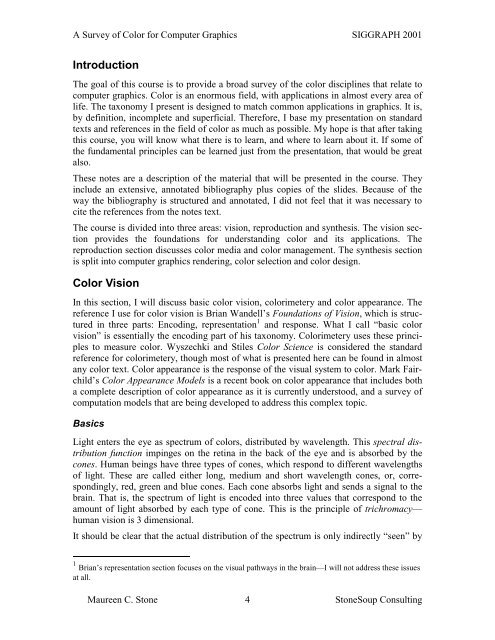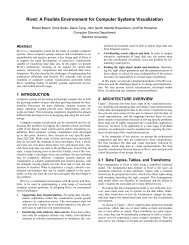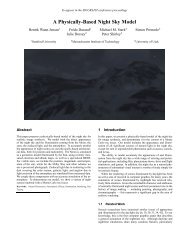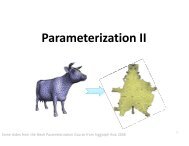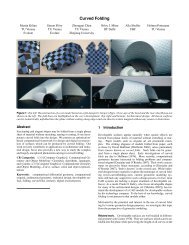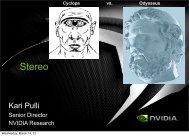A Survey of Color for Computer Graphics
A Survey of Color for Computer Graphics
A Survey of Color for Computer Graphics
Create successful ePaper yourself
Turn your PDF publications into a flip-book with our unique Google optimized e-Paper software.
A <strong>Survey</strong> <strong>of</strong> <strong>Color</strong> <strong>for</strong> <strong>Computer</strong> <strong>Graphics</strong> SIGGRAPH 2001<br />
Introduction<br />
The goal <strong>of</strong> this course is to provide a broad survey <strong>of</strong> the color disciplines that relate to<br />
computer graphics. <strong>Color</strong> is an enormous field, with applications in almost every area <strong>of</strong><br />
life. The taxonomy I present is designed to match common applications in graphics. It is,<br />
by definition, incomplete and superficial. There<strong>for</strong>e, I base my presentation on standard<br />
texts and references in the field <strong>of</strong> color as much as possible. My hope is that after taking<br />
this course, you will know what there is to learn, and where to learn about it. If some <strong>of</strong><br />
the fundamental principles can be learned just from the presentation, that would be great<br />
also.<br />
These notes are a description <strong>of</strong> the material that will be presented in the course. They<br />
include an extensive, annotated bibliography plus copies <strong>of</strong> the slides. Because <strong>of</strong> the<br />
way the bibliography is structured and annotated, I did not feel that it was necessary to<br />
cite the references from the notes text.<br />
The course is divided into three areas: vision, reproduction and synthesis. The vision section<br />
provides the foundations <strong>for</strong> understanding color and its applications. The<br />
reproduction section discusses color media and color management. The synthesis section<br />
is split into computer graphics rendering, color selection and color design.<br />
<strong>Color</strong> Vision<br />
In this section, I will discuss basic color vision, colorimetery and color appearance. The<br />
reference I use <strong>for</strong> color vision is Brian Wandell’s Foundations <strong>of</strong> Vision, which is structured<br />
in three parts: Encoding, representation 1 and response. What I call “basic color<br />
vision” is essentially the encoding part <strong>of</strong> his taxonomy. <strong>Color</strong>imetery uses these principles<br />
to measure color. Wyszechki and Stiles <strong>Color</strong> Science is considered the standard<br />
reference <strong>for</strong> colorimetery, though most <strong>of</strong> what is presented here can be found in almost<br />
any color text. <strong>Color</strong> appearance is the response <strong>of</strong> the visual system to color. Mark Fairchild’s<br />
<strong>Color</strong> Appearance Models is a recent book on color appearance that includes both<br />
a complete description <strong>of</strong> color appearance as it is currently understood, and a survey <strong>of</strong><br />
computation models that are being developed to address this complex topic.<br />
Basics<br />
Light enters the eye as spectrum <strong>of</strong> colors, distributed by wavelength. This spectral distribution<br />
function impinges on the retina in the back <strong>of</strong> the eye and is absorbed by the<br />
cones. Human beings have three types <strong>of</strong> cones, which respond to different wavelengths<br />
<strong>of</strong> light. These are called either long, medium and short wavelength cones, or, correspondingly,<br />
red, green and blue cones. Each cone absorbs light and sends a signal to the<br />
brain. That is, the spectrum <strong>of</strong> light is encoded into three values that correspond to the<br />
amount <strong>of</strong> light absorbed by each type <strong>of</strong> cone. This is the principle <strong>of</strong> trichromacy—<br />
human vision is 3 dimensional.<br />
It should be clear that the actual distribution <strong>of</strong> the spectrum is only indirectly “seen” by<br />
1 Brian’s representation section focuses on the visual pathways in the brain—I will not address these issues<br />
at all.<br />
Maureen C. Stone 4<br />
StoneSoup Consulting


